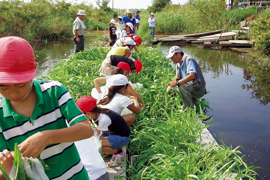The Mitsui & Co. Environment Fund
Introduction to Grant Projects
Inbanuma Yasai Ikada no Kai (Inba Swamp Vegetable Raft Association)
The recovery of endangered species of aquatic plants at the Inbanuma wetlands and learning through experiencing the environment
Activity grant
- Project Description
As a result of the urbanization of low-lying watersheds and socioeconomic activities, the quality of the water in the Inbanuma wetlands has rapidly degraded through the input of domestic and agricultural waste water, and aquatic organisms are in danger of extinction. Use "aquatic plant regenerating rafts" to hold water plants (underwater and floating types) that have disappeared from the wetlands to artificially recreate shallow water conditions in an environmentally friendly manner, to enable the regeneration of aquatic plants that are in danger of disappearing altogether. Carry out operations aimed at all residents of the low-lying areas, to help return the wetlands to clean state that is familiar to the areas near water, and advance the protection of ecosystems and biodiversity.
- Fields
- Preservation of biodiversity and ecosystem
- Grant year
- FY2012 Activity Grants
- Grant term
- 3 years
October 2012 - September 2015
- Grant amount
- 2,580,000 yen
- Activity region
- An agricultural canal adjacent to Nishi Inbanuma and the wetlands

Overview of the Organization

- Representative
- Yasuo Mishima, Director
- Establishment
- 2000
- Establishment purpose
- Reclamation projects in the mid-1960s reduced the size of the wetlands and closed off the lake. Urbanization of the watershed area and agricultural intensification rapidly rapidly increased the water pollution burden. Although used as the tap water source for some 1.5 million people in the Chiba Prefecture basin, the quality significantly exceeds the environmental standard stipulated by the Ministry of the Environment but is frequently mentioned as one of the worst-polluted lake water-sources in Japan. This project aims to revitalize the water environment and make it well-known to all residents of the Inbanuma basin.
- Main regions of project activity
- Nishi Inbanuma, an agricultural canal adjacent to Nishi Inbanuma and the wetlands, Lake Tangon in Hanoi (Vietnam)
- Staff
- 1 full-time member, 15 part-time members, 230 full members
- Annual operating budget
- 27.94 million yen in 2009, 10.2 million yen in 2010, 10.5 million yen in 2011
- Affiliated organizations
- Natural History Museum and Institute, Chiba; Inbanuma Ryuuiki Suijunkan Kenzen-ka Kaigi
- Main activities
-
- (1) Use "aquatic plant regenerating rafts" to artificially create shallow water conditions, and through a combination of the revival of aquatic plants that are in danger of disappearing as well as the introduction of bivalves (pond pearl shellfish — freshwater pearls) absorb and suppress the levels of nitrogen and phosphorus that are the cause of outbreaks of blue-green algae blooms that threaten the destruction of the ecosystem. In addition, these absorb organic substances that are responsible for water turbidity to help establish an ecosystem in which the water has a high level of clarity that allows sunlight to penetrate to the lake bottom and promote the breeding of small aquatic creatures.
- (2) Learning through experiencing the environment is carried out in collaboration with local elementary and junior high schools in the months of July to September, and tells the children about the importance of the aquatic environment.